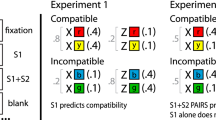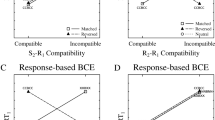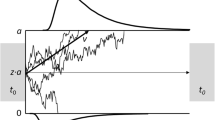Abstract
Three experiments using psychological refractory period (PRP) tasks documented backward crosstalk effects in which the nature of the second-task response influenced the first-task response latencies. Such effects are difficult to explain within currently popular bottleneck models, according to which second-task response selection does not begin until first-task response selection has finished. In Experiments 1 and 2, the first of the PRP tasks required a choice reaction time (RT) response, whereas the second task required a go/no-go decision. Task 1 responses were faster when the second task required a go response than when it required a no-go response. Experiment 3 showed that Task 1 RTs were also influenced by the complexity of second-task responses. These backward crosstalk effects indicate that significant second-task processing is carried out in time to influence first-task responses and thus challenge strictly serial bottleneck models.


Similar content being viewed by others
Notes
Moreover, Logan and Schulkind (2000, Experiments 3 and 4) found no evidence of backward crosstalk in PRP paradigms using two manual responses, so it is clear that the use of two manual responses is not sufficient by itself to cause such crosstalk.
Chamberlin (1987) found no effect of second-task response complexity on RT1 with a simple RT task as the first task, but simple RT responses seem unlikely to be influenced by crosstalk in the first place because they can be completely preplanned.
References
Adam, J. J., & Van Veggel, L. M. (1991). Discrete finger response latencies in a simple reaction time task. Perceptual and Motor Skills, 73, 863–866.
Bertelson, P., & Tisseyre, F. (1969). Refractory period of C-reactions. Journal of Experimental Psychology, 79, 122–128.
Brunia, C. H. (1983). Motor preparation: Changes in amplitude of Achilles tendon reflexes during a fixed foreperiod of one second. Psychophysiology, 20, 658–664.
Chamberlin, C. J. (1987). Effect of complexity of the second response on reaction time to the first response in the psychological refractory period paradigm. Perceptual and Motor Skills, 64, 1075–1080.
De Jong, R. (1993). Multiple bottlenecks in overlapping task performance. Journal of Experimental Psychology: Human Perception and Performance, 19, 965–980.
Donders, F. C. (1868/1969). Over de snelheid van psychische processen. [On the speed of mental processes.] (W. G. Koster, Trans.). In W. G. Koster (Ed.), Attention and performance II (pp. 412–431). Amsterdam: North Holland.
Duncan, J. (1977). Response selection rules in spatial choice reaction tasks. In S. Dornic (Ed.), Attention and performance VI (pp. 49–62). Hillsdale, NJ: Erlbaum.
Gemba, H., Sasaki, K., & Tsujimoto, T. (1990). No-go potential in monkeys and human subjects. In C. H. M. Brunia, A. W. K. Gaillard, & A. Kok (Eds.), Psychophysiological brain research, vol. 1 (pp. 133–136). Tilburg, The Netherlands: Tilburg University Press.
Gottsdanker, R. (1969). Interacting responses to crowded signals. Acta Psychologica, 30, 168–176.
Hackley, S. A., & Miller, J. O. (1995). Response complexity and precue interval effects on the lateralized readiness potential. Psychophysiology, 32, 230–241.
Hackley, S. A., & Valle-Inclán, F. (1999). Accessory stimulus effects on response selection: Does arousal speed decision making? Journal of Cognitive Neuroscience, 11, 321–329.
Hazeltine, E., Teague, D., & Ivry, R. B. (2002). Simultaneous dual-task performance reveals parallel response selection after practice. Journal of Experimental Psychology: Human Perception and Performance, 28, 527–545.
Heil, M., Osman, A. M., Wiegelmann, J., Rolke, B., & Hennighausen, E. (2000). N200 in the Eriksen-task: Inhibitory executive process? Journal of Psychophysiology, 14, 218–225.
Henry, F. M., & Rogers, D. (1960). Increased response latency for complicated movements and a “memory drum” theory of neuromotor reaction. Research Quarterly, 31, 448–458.
Hommel, B. (1998). Automatic stimulus–response translation in dual-task performance. Journal of Experimental Psychology: Human Perception and Performance, 24, 1368–1384.
Hommel, B., & Eglau, B. (2002). Control of stimulus–response translation in dual-task performance. Psychological Research, 66, 260–273.
Kerr, B. (1983). Preplanning for aimed movements: Disruption from a preliminary task. Journal of Experimental Psychology: Human Perception and Performance, 9, 596–606.
Kornblum, S., Hasbroucq, T., & Osman, A. M. (1990). Dimensional overlap: Cognitive basis for stimulus–response compatibility—a model and taxonomy. Psychological Review, 97, 253–270.
Lien, M. C., & Proctor, R. W. (2000). Multiple spatial correspondence effects on dual-task performance. Journal of Experimental Psychology: Human Perception and Performance, 26, 1260–1280.
Logan, G. D., & Delheimer, J. A. (2001). Parallel memory retrieval in dual-task situations: II. Episodic memory. Journal of Experimental Psychology: Learning, Memory, and Cognition, 27, 668–685.
Logan, G. D., & Schulkind, M. D. (2000). Parallel memory retrieval in dual-task situations: I. Semantic memory. Journal of Experimental Psychology: Human Perception and Performance, 26, 1072–1090.
Meyer, D. E., & Kieras, D. E. (1997). A computational theory of executive cognitive processes and multiple-task performance: Part 2. Accounts of psychological refractory-period phenomena. Psychological Review, 104, 749–791.
Miller, J. O., & Alderton, M. (2002). Backward motor crosstalk in a psychological refractory period task. Presentation at the annual meeting of the Psychonomic Society, Kansas City, November.
Miller, J. O., & Reynolds, A. (2003). The locus of redundant-targets and nontargets effects: Evidence from the psychological refractory period paradigm. Journal of Experimental Psychology: Human Perception and Performance, 29, 1126–1142.
Muroi, M., Naito, E., & Matsumura, M. (1997). Evidence for psychological refractory effect in motor inhibition for a dual-response go/no-go task. Perceptual and Motor Skills, 85, 563–568.
Navon, D. (1984). Resources—a theoretical soup stone? Psychological Review, 91, 216–234.
Navon, D., & Miller, J. O. (2002). Queuing or sharing? A critical evaluation of the single-bottleneck notion. Cognitive Psychology, 44, 193–251.
Pashler, H. E. (1984). Processing stages in overlapping tasks: Evidence for a central bottleneck. Journal of Experimental Psychology: Human Perception and Performance, 10, 358–377.
Pashler, H. E., Johnston, J. C., & Ruthruff, E. D. (2000). Attention and performance. Annual Review of Psychology, 52, 629–651.
Posner, M. I., Nissen, M. J., & Klein, R. M. (1976). Visual dominance: An information-processing account of its origins and significance. Psychological Review, 83, 157–171.
Ruthruff, E. D., Johnston, J. C., & Van Selst, M. (2001). Why practice reduces dual-task interference. Journal of Experimental Psychology: Human Perception and Performance, 27, 3–21.
Ruthruff, E. D., Johnston, J. C., Van Selst, M., Whitsell, S., & Remington, R. (2003). Vanishing dual-task interference after practice: Has the bottleneck been eliminated or is it merely latent? Journal of Experimental Psychology: Human Perception and Performance, 29, 280–289.
Ruthruff, E. D., Miller, J. O., & Lachmann, T. (1995). Does mental rotation require central mechanisms? Journal of Experimental Psychology: Human Perception and Performance, 21, 552–570.
Ruthruff, E. D., Pashler, H. E., & Klaassen, A. (2001). Processing bottlenecks in dual-task performance: Structural limitation or strategic postponement? Psychonomic Bulletin & Review, 8, 73–80.
Sasaki, K., Gemba, H., Nambu, A., & Matsuzaki, R. (1993). No-go activity in the frontal association cortex of human subjects. Neuroscience Research, 18, 249–252.
Schumacher, E. H., Seymour, T. L., Glass, J. M., Fencsik, D. E., Lauber, E. J., Kieras, D. E., et al. (2001). Virtually perfect time sharing in dual-task performance: Uncorking the central cognitive bottleneck. Psychological Science, 12, 101–108.
Sternberg, S. (1969a). The discovery of processing stages: Extensions of Donders’ method. Acta Psychologica, 30, 276–315.
Sternberg, S. (1969b). Memory scanning: Mental processes revealed by reaction-time experiments. American Scientist, 57, 421–457.
Stief, V., Leuthold, H., Miller, J. O., Sommer, W., & Ulrich, R. (1998). The effect of response complexity on the lateralized readiness potential. Zeitschrift für Psychologie, 206, 305–319.
Tombu, M., & Jolicœur, P. (2003). A central capacity sharing model of dual-task performance. Journal of Experimental Psychology: Human Perception and Performance, 29, 3–18.
Van Duren, L. L., & Sanders, A. F. (1988). On the robustness of the additive factors stage structure in blocked and mixed choice reaction designs. Acta Psychologica, 69, 83–94.
Van Selst, M., & Jolicœur, P. (1994). Can mental rotation occur before the dual-task bottleneck? Journal of Experimental Psychology: Human Perception and Performance, 20, 905–921.
Vincent, S. B. (1912). The function of the viborissae in the behavior of the white rat. Behavioral Monographs, 1 (5), 1–82
Welford, A. T. (1967). Single-channel operation in the brain. Acta Psychologica, 27, 5–22.
Acknowledgements
This research was supported by a grant to Jeff Miller from the Marsden Fund administered by the Royal Society of New Zealand. The author thanks Lisa Maughan for assistance in collecting the data and Mark Alderton, Bernhard Hommel, Iring Koch, Rolf Ulrich, and an anonymous reviewer for constructive comments on earlier versions of the article.
Author information
Authors and Affiliations
Corresponding author
Rights and permissions
About this article
Cite this article
Miller, J. Backward crosstalk effects in psychological refractory period paradigms: effects of second-task response types on first-task response latencies. Psychological Research 70, 484–493 (2006). https://doi.org/10.1007/s00426-005-0011-9
Received:
Accepted:
Published:
Issue Date:
DOI: https://doi.org/10.1007/s00426-005-0011-9




